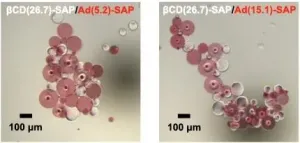(Press-News.org) A considerably higher dose of the anti-tuberculosis drug rifampicin is safe and can also lead to a shorter treatment for tuberculosis and less resistance. This is what researchers from Radboud university medical center in Nijmegen, the Netherlands, write in a recent publication. With this they complete a year-long search for the right dosing of an old drug against tuberculosis that appears to be the key drug.
Tuberculosis is a deadly, pertinacious bacterial infectious disease that affects nine million people worldwide each year, mainly in countries in low and middle income countries. For over a million, the disease has a fatal outcome. Although drug manufacturers have been developing tuberculosis drugs for forty years, supplemented by research on the BCG vaccine, which appears to strengthen the immune system against respiratory infections, the number of people affected by tuberculosis remains fairly stable. This is partly due to patients being treated for too short a time or with inadequate medication.
Resistance
Due to TB treatment being inadequately dosed or too short, many drugs do not or barely reach all bacilli in the body. This can lead to resistance: the pathogens that survive the treatment multiply, after which the disease returns in a new form that is even more difficult to treat. Effective treatments for drug-resistant tuberculosis are therefore tough and last a long time, sometimes up to eighteen months.
"It's a smart disease," says Prof. Dr. Martin Boeree, Professor of Clinical Tuberculosis at Radboudumc and last author of the study recently published in the European Respiratory Journal. "The tubercle bacillus is able to evade body defenses and drugs by getting ín body cells. As a result, the immune system cannot kill the bacilli, but at best traps them in vesicles." As a result, tuberculosis can sometimes emerge years after infection.
Old wonder drug turns out to be underdosed
One of the few effective drugs against tuberculosis is rifampicin. Even after fifty years, this remains one of the few anti-tuberculosis drugs that penetrates all parts of the body, including those hard-to-reach vesicles and cavities where the tubercle bacillus resides. Yet all this time, patients have been receiving too low a dosage, of only 10 milligrams per kilogram of body weight. "A higher dose was too expensive at the time, people were afraid that the drug would be toxic, and in 95 percent of cases the dose was sufficiently effective," says Boeree. "That's why the maximum tolerated dose was never examined. And yet if the dosage is too low, you encourage resistance in the remaining five percent. You want to avoid that because it makes you dependent on other drugs. There are not many of these and they are much more expensive. In poorer countries, that can easily become a problem."
This applies to a lesser extent to rifampicin, which has been permitted on the drug market for decades and is therefore cheaper to produce than the new drugs. Boeree and his colleagues decided in 2016 to set up a collaboration to still explore the characteristics of rifampicin, including the maximum tolerated dose. "The cost remains low because the drug has been on the market for so long," says Boeree. "In addition, at six months, the current treatment period for rifampicin is already shorter than the standard twelve to eighteen. With a higher dose, it could perhaps be even shorter, resulting in greater compliance."
End of a quest
The researchers completed the first part of that study in 2019. "To our surprise, the drug turned out to be perfectly tolerable up to 35 milligrams per kilogram of body weight: 3.5 times the original dose," says Boeree. "A safe, higher dose gives better treatment results."
With the recent publication by Lindsey te Brake and her Radboudumc colleagues, the search for the maximum dose of rifampicin is now complete. "The 2019 study showed that we could go even further in rifampicin dosing," says Boeree. "We now know that at 50 milligrams per kilo, patients suffer from a kind of general malaise. But a dose of 40 milligrams per kilo does not produce severe side effects."
Research with global impact
Whether a higher dose of rifampicin can actually lead to a shorter treatment duration and less resistance is difficult to say on the basis of their research at this point of time. Te Brake, Boeree and their colleagues will therefore begin follow-up research this summer to determine the actual outcome of their new treatment strategy. "If we know how many patients have recurrent tuberculosis after a year, and we compare this to a control group, we can make a prediction of how well this new regimen may work," says Boeree.
"We think that a large proportion of patients will not need six months of rifampicin if we give it at a higher dose," Boeree says. "It's quite possible that three months is enough." If that turns out to be the case, he says, it will have a very big impact in the treatment of tuberculosis worldwide. "The shorter the treatment, the higher the adherence and the lower the resistance. With this study, we can increase the effectiveness of this crucial drug."
INFORMATION:
About the publication in European Respiratory Journal
Increased bactericidal activity but dose-limiting intolerability at 50 mg-kg-1 rifampicin. Lindsey te Brake, Veronique de Jager, Kim Narunsky, Naadira Vanker, Elin Svensson, Patrick Phillips, Stephen Gillespie, Norbert Heinrich, Michael Hoelscher, Rodney Dawson, Andreas Diacon, Rob Aarnoutse, Martin Boeree.
Northwestern engineering researchers have demonstrated a new approach to chemical catalysis that results in high propylene yields using less energy. The findings could support more energy-efficient production processes for many plastics.
One of the highest volume chemical products, more than $100 billion worth of propylene is produced each year and used primarily to produce polypropylene for a variety of materials, from injection moldings in car parts to consumer products. Producing propylene is also energy intensive, requiring temperatures around 800 degrees Celsius to convert propane gas to propylene.
One technique, called oxidative dehydrogenation, ...
A researcher from Skoltech has filled in the gaps connecting quantum simulators with more traditional quantum computers, discovering a new computationally universal model of quantum computation, the variational model. The paper was published as a Letter in the journal Physical Review A. The work made the Editors' Suggestion list.
A quantum simulator is built to share properties with a target quantum system we wish to understand. Early quantum simulators were "dedicated" - that means they could not be programmed, tuned or adjusted and so could mimic one or very few target systems. Modern quantum simulators enable some control over their settings, offering more possibilities.
In contrast to quantum simulators, the long-promised quantum computer is a fully programmable quantum system. While ...
A Korean research team has recently developed an innovative vesico-vaginal fistula treatment method using the mussel adhesive protein (MAP) that can effectively seal fistulas in organs even when exposed to urine.
Professor Hyung Joon Cha, Dr. Hyo Jeong Kim (currently at Korea Research Institute of Chemical Technology), and Dr. Tae Yoon Park of POSTECH's Department of Chemical Engineering with Professor Seok Ho Kang of the Department of Urology at Korea University School of Medicine and Professor Jong Hyun Pyun of the Department of Urology at Kangbuk Samsung Hospital have together improved the underwater adhesive using mussel protein and applied it to a pig model that simulated a vesico-vaginal fistula. ...
Osaka, Japan - Scientists from the Graduate School of Science at Osaka University created superabsorbent polymer (SAP) microparticles that self-assemble into structures that can be modified by adjusting the proportion of particle type. This research may lead to new tunable biomimetic "smart materials" that can sense and respond to specific chemicals.
Biological molecules in living organisms have a remarkable ability to form self-assembled structures when triggered by an external molecule. This has led scientists to try to create other "smart materials" that respond to their environment. Now, a team of researchers at Osaka University has come up with a tunable system involving poly(sodium acrylate) microparticles that can have one of two types of chemical ...
The white paper, published today (March 22) by REPHRAIN, the National Research Centre on Privacy, Harm Reduction and Adversarial Influence Online in collaboration with the Dutch National Police, offers a solution to big data problems that tend to hamper police probes into this type of law-breaking.
The practice of attribution - who did what - is becoming increasingly complex as organised crimes incorporate deception, deletion and encryption in today's Information Age. Even when law enforcement are able to retrieve evidence via digital forensics, the complexities of the collected data mean it cannot be easily processed into factual police reports. ...
One prospective source of renewable energy is hydrogen gas produced from water with the aid of sunlight. Researchers at Linköping University, Sweden, have developed a material, nanoporous cubic silicon carbide, that exhibits promising properties to capture solar energy and split water for hydrogen gas production. The study has been published in the journal ACS Nano.
"New sustainable energy systems are needed to meet global energy and environmental challenges, such as increasing carbon dioxide emissions and climate change", says Jianwu Sun, senior lecturer in the ...
A lot of the attention around "pandemic pets" has focused on families with children getting a cat, dog or other pet in 2020, during a time when many people were learning or working from home.
But a new poll shows that older adults also got in on the trend.
According to the National Poll on Healthy Aging, 10% of all people between the ages of 50 and 80 got a new pet between March 2020 and January 2021.
The percentage was indeed higher - 16% -- among the people in this age range who have at least one child or teen living with them. But the vast majority of people between the ages of 50 and 80 don't live with someone under age 18 -- and nearly 9% of them also got a pet during the pandemic.
All told, 59% of people age 50 to 80 who completed the poll in January 2021 are pet owners. ...
The Covid-19 pandemic severely impacted the mental health of young people, with increased levels of clinical depression being identified, a new study published in the journal Psychiatry Research reports. A decrease in alcohol consumption was also identified amongst young people during the pandemic.
During this unique study researchers from the University of Surrey surveyed 259 young people pre- pandemic (autumn 2019) and in the midst of initial lockdown measures (May/June 2020) on their levels of depression, anxiety, wellbeing, alcohol use and sleep quality.
Researchers found evidence of a substantial impact on the mental health of these young adults due ...
Research has found that experiencing a traumatic event at close quarters changes people's political attitudes. However, in the case of the 2017 terrorist attack in Stockholm, proximity to the attack had no additional political significance. Research from the University of Gothenburg shows that Swedes' attitudes toward terrorism-related questions were affected equally, regardless of whether they happened to be close to the attack.
On 7 April 2017, Rakhmat Akilov stole a truck and ran down multiple people on Drottninggatan, a street in central Stockholm. Five people died, fifteen were injured and many people witnessed ...
A study which looked at activity levels before and during the COVID-19 pandemic has found lockdown restrictions significantly reduced light activity associated with socialising and work.
The study, published recently in BMJ Neurology and led by King's College London, examined how activity levels changed in study participants with muscular dystrophy and other inheritable myopathies. The sample included people with a range of physical abilities, from highly independent to assisted mobility, including 41 wheelchair users, who are often underrepresented in research. However, the authors say the findings are likely to be relevant to adults of various ...



